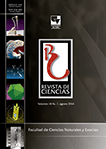Electrochemical Characterization of Mass Transport at Microelectrode Arrays
Contenido principal del artículo
Electrodes with dimensions in the micro- and nano-meter scale can be used as analytical probes in confi ned places such as cells and organelles. Arrays of microelectrodes, particularly disk-shaped electrodes, are now a platform to fabricate electrochemical sensors and multisensors. A useful characteristic of such arrays is that enhancement of the current signal is due to the fact that radial diffusion becomes important as the disk radius gets smaller and steady state currents are attainable in a relatively short time. Because there is no general analytical solution for the current response at MEAs, previous characterization of any micro electrode array at hand is still required. This paper discusses the electrochemical characterization of the mass transport of a reversible electrochemical probe at a commercially available micro-disk electrode array by two commonly used tools for electro analysis, namely: cyclic voltammetry and chronoamperometry. The questions to be addressed are whether clear radial diffusion control can be effectively achieved and the time required for the electrode system to reach steady state. For chronoamperometric experiments, the current response almost achieves steady state in the time range between 0.49 s and 1 s. This is precisely the time bracket in which analytical measurements should be made in order to achieve high sensitivity.
- Walter Torres Hernández, An Electrochemical Desalination Cell Based On Conducting Polymers , Revista de Ciencias: Vol. 21 Núm. 1 (2017)
- Walter Torres Hernández, Análisis por XPS de la Formación de Nitruros en un Catalizador de Carburo de Tungsteno para la Decomposición de Amoníaco , Revista de Ciencias: Vol. 13 (2009)
- Maira Raquel Cerón Hernández, Gala Paulina de la Vega Quintero, Walter Torres Hernández, Germania Micolta Salazar, Esperanza Galarza de Becerra, Síntesis y caracterización espectroscópica de los productos de reacción entre [Ru 3 (CO) 12 ] y el ligando cloroarilidenrodanina , Revista de Ciencias: Vol. 18 Núm. 1 (2014)

Esta obra está bajo una licencia internacional Creative Commons Atribución-NoComercial-CompartirIgual 4.0.





